This post is written quickly and opportunistically, so please excuse any errors of syntax or content. I started writing it at 2 AM and finished some time around 7, but the ire flows through my veins, giving me unnatural strength and preventing sleep. Please bear with me.
Set Side B is about all forms of niche electronic gaming, and I figure you don’t get more niche than the app of the New York Times Crossword Puzzle, Android version. Even if, in fact, especially if you have no prior experience or interest in crosswords or doing them, this should serve as a window, both into a rather insane subculture and its crazy UI requirements.
The New York Times Crossword is an institution. It’s the gold standard of the form. Famous and powerful people, folk like Bill Clinton and Jon Stewart, are known to do it every day. I do it too for some reason. I’ve followed the career of famed puzzle editor Will Shortz since his 15-year tenure at the hugely underrated GAMES Magazine, which I bought issues of as a very weird kid.
I’ve been planning a post on the crossword itself for some time. This is not that post, that will have to wait until later, because boy howdy, there is a lot to explicate. I have a long essay on puzzle weirdness and solving advice in the works, but I want to get to one specific aspect that takes a lot of new solvers by surprise, in the same way a brick wall takes a speeding car by surprise.
This is your only warning that this post contains three solved puzzles. They’re here to illustrate what the hell a rebus puzzle is. This necessarily contains spoilers. The puzzles shown are May 12 and February 10th of this year, as well as July 17th, yesterday.
The NYTXC is known for its playfulness. Especially on Thursdays, you can expect a number of weird tricks to pop up from time to time when solving them. There’s many of these, far more than I can or should catalog here, and every once in a while a new one appears, but among the more confounding are what are known as rebus puzzles. They pose special problems for the solvers who have to struggle with them, and the people who have to maintain their app.
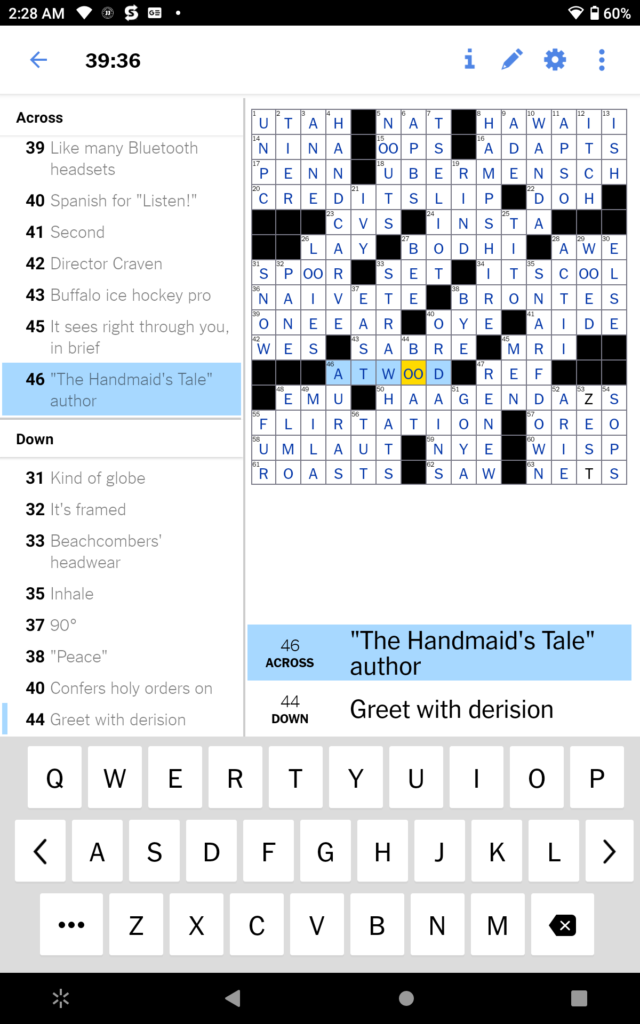
Sometimes when working on a puzzle, most frequently on a Thursday, you’ll find clues that seem to indicate answers that couldn’t possibly fit in the number of squares provided. That’s a good indication there’s a rebus gimmick. Here are a couple of illustrative examples.
From May 12th. 46 Across: “The Handmaid’s Tale” author. Oh that’s easy, Margaret Atwood! No, no, wait, ATWOOD is six letters, and there’s only five spaces.
Could they mean something else? Sometimes they do! Crossword puzzles have a whole world of idiosyncratic rules and tricks that I look forward to introducing you to in the future. But in this instance those don’t matter, because it’s a rebus puzzle.
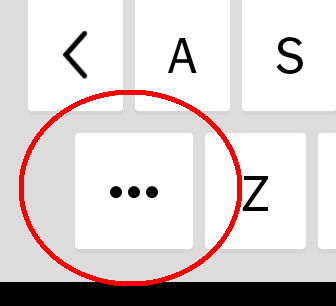
At the bottom-right corner of the keyboard in that screenshot, notice the button with the three dots? That’s the cursed rebus button, doorway to an alternate universe, one where multiple letters, or even other things entirely, can fit in a single square. It opens a text entry box into which you can write almost anything, and of any length. In this case, it’s two letters OO that are put in the square. This is done in multiple places in the puzzle.
I must emphasize, this is not breaking the rules. Sometimes puzzles do break the rules, although they must let the solver know, in some way, that they’re being broken. But this is a special carve out. New York Times crossword puzzles are allowed to do this. This isn’t done willy-nilly, though. Whenever there are rebus squares, the puzzle must at least be consistent about them, and, in the current era at least, it’s always hinted to the solver in some way. But it’s not outright stated. Rebus puzzles lurk in wait, ready to pounce. They don’t erect signposts pointing out their hiding spot.
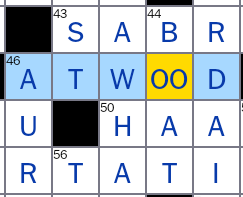
This hint could be in a puzzle title (available from the i button at the top), but more often one of the answers in the puzzle will refer to it. In this one, that answer is to 58 Across: Diacritical mark resembling a dieresis, both of which are represented in this puzzle, to which the answer is UMLAUT. Those self-referential clues are an almost sure sign of some screwy shenanigan.
Also note, in this case, the answer doesn’t actually name the trick visible in the solved puzzle. A double-O is neither an umlaut or a dieresis. Since rebus puzzles are sometimes a bit representational, they usually accept multiple possible answers for the tricky squares. You just have to be ready for this sort of thing in New York Times crossword puzzles.
Rebus puzzles are a bit shocking when they appear, but they’re not actually that common. There might be one rebus puzzle, on average, every month or so. It’s been calculated that 4.7% of all Shortz-era NYT crosswords are rebus puzzles. People vary in how receptive they are to them. When I first encountered one it was from a puzzle in a collection, and I felt like a bit of a genius for figuring out what they were looking for without prompting. A friend of mine who also does these puzzles is not much of a fan. He prefers a more orderly kind of puzzle that makes no mockery of the standards of the Cartesian grid. A second friend (Surprise! I have more than one!) loves tricks like rebus answers, and other gimmicks that step outside expected norms and rules.
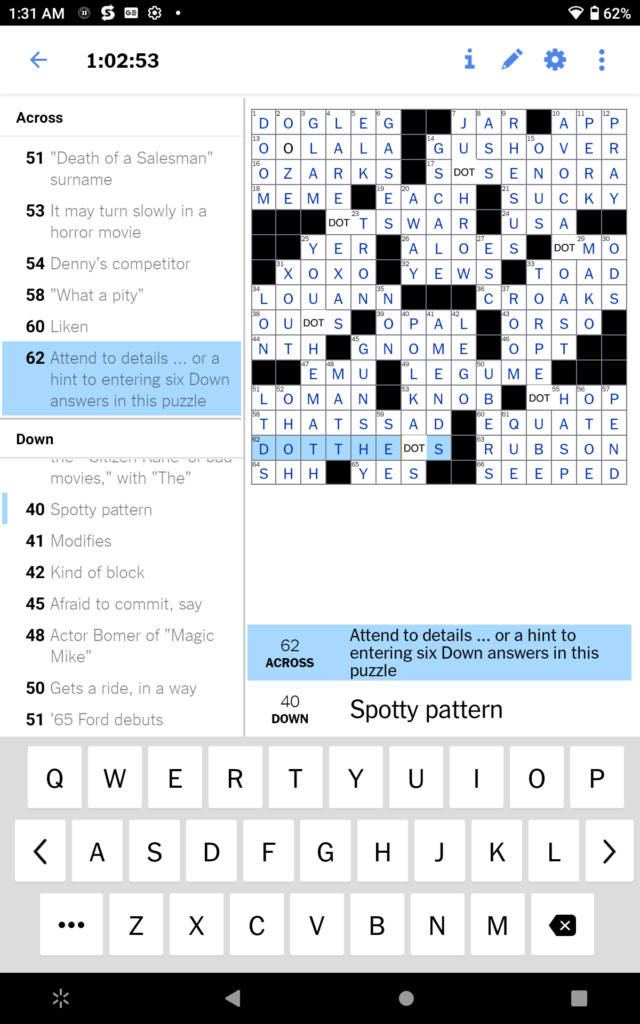
One more thing to notice about that specific puzzle is that the OO squares read both horizontally and vertically. The clue that crosses with it is 44 Down: Greet with derision, the answer: BOO AT. This is not always the case with rebus puzzles.
Feb 10th. This screenshot doesn’t show the solution accurately, I’ll tell you that right now. The key clue is 62 Across: Attend to details … or a hint to entering six Down answers in this puzzle. The thing here is, the rebus squares read differently whether you’re reading them across or down. Across, the answers are supposed to be I, just a single letter I, but down they read DOT. So the answer to this clue is DOT THE I S.
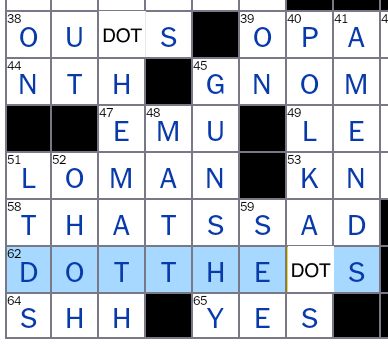
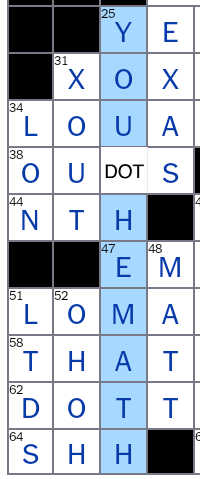
While the square here is depicted as just DOT, it’s intended to be read as just an “I” horizontally. Often, as in this case, the hint answer in a rebus puzzle is, itself, one of the rebus answers, which requires a bit of intuition when solving. But the vertical (to the left) is meant to be read as DOT: POLKA (DOT)S.
The other DOT there (in the image to the right) has the clues 38 Across: French agreements (OUIS) and 25 Down: “It’s not hard to guess how this will end.” (YOU [DO T]HE MATH).
The NYT Crosswords are selected mostly with consideration for how they will be solved in print, so some of the tricks are difficult to represent in the app. Rebus squares that read differently across and down is a common enough problem that there is a convention to entering them. You’re usually supposed to enter the across answer, a forward slash (not a backslash, we have standards here), then the down answer. Like this:
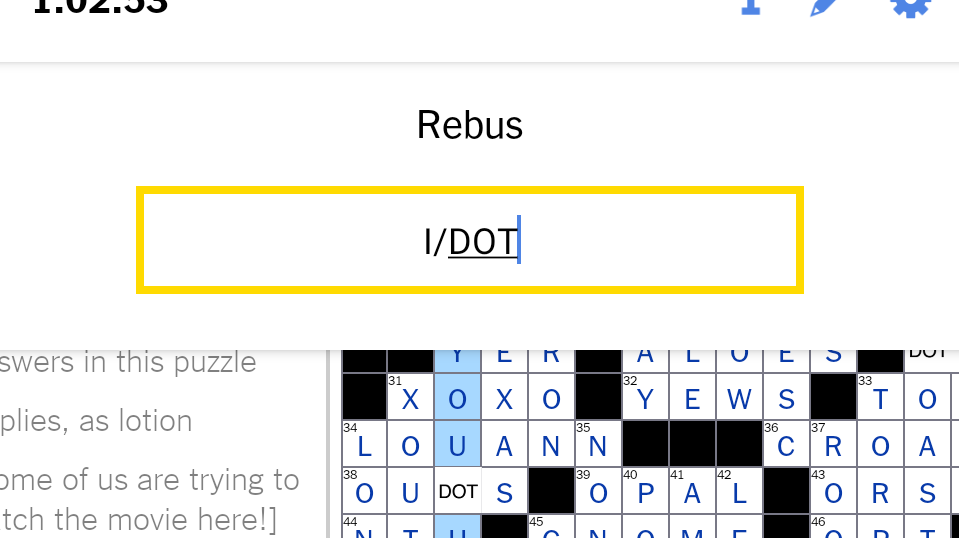
Often you can enter just the first letter of each of the directional answers and it will be accepted, but to me it’s not really solved until you have the entire text filled in.
By the way! Where in the instructions is this laid out to the solver? They aren’t laid out there. They aren’t laid out anywhere. There are no instructions. Go directly to hell do not collect $200. (That’s how much the New York Times pays an author for a standard weekday puzzle, by the way.)
I think the reason for not explicitly laying out the convention is to avoid ruining, for solvers, the experience of discovering, that first time, that crossword puzzles are allowed to engage in this kind of fuckery (excusez-moi). I found out about the convention from Google, though, which I have to say, is not the right place to learn it.
The stakes for getting it right are very low, but still, greater than zero. The app keeps track of whether you solve a puzzle within the 26-hour period after its appearance. Puzzles go up the day before at 10 PM (Eastern time, at least), and to qualify for a streak it has to be done before midnight the day after. If you don’t enter the right configuration into the puzzle within that time, any streak you were on will end, and you won’t get the golden icon for that puzzle. If you can’t accurately enter rebus answers the way the app expects, you have no chance of that happening.
But of course, no one takes that seriously. No, of course not! Heaven forfend!
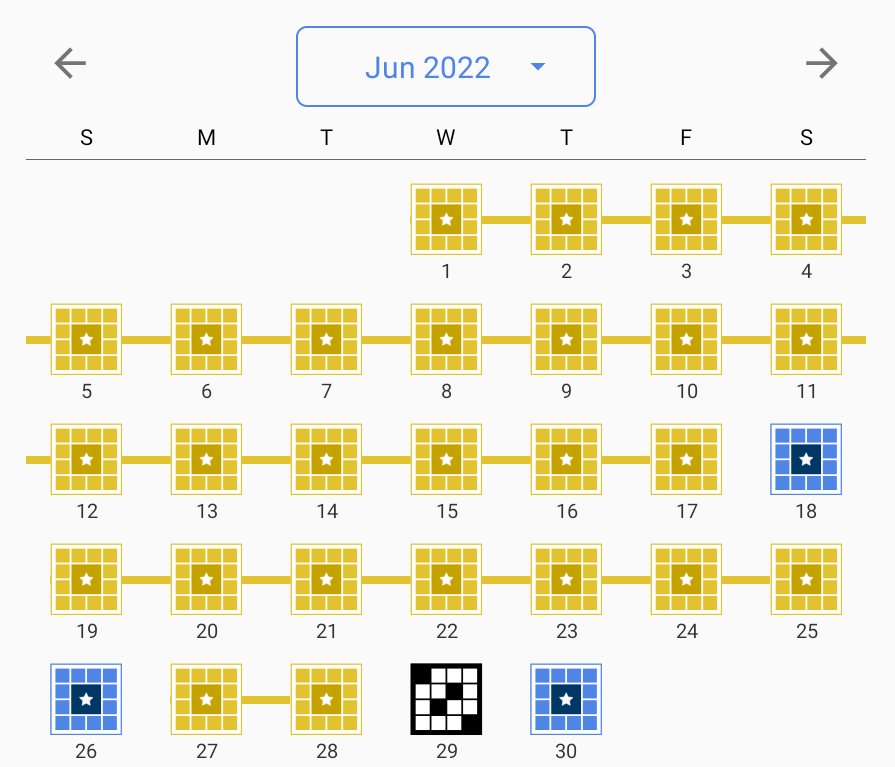
Isn’t it funny how I said I wasn’t going to do a lengthy preamble, and yet, I just did one? But you have to know about rebus puzzles and the challenges the developers face to support them to understand how they messed up yesterday, Sunday, July 18.
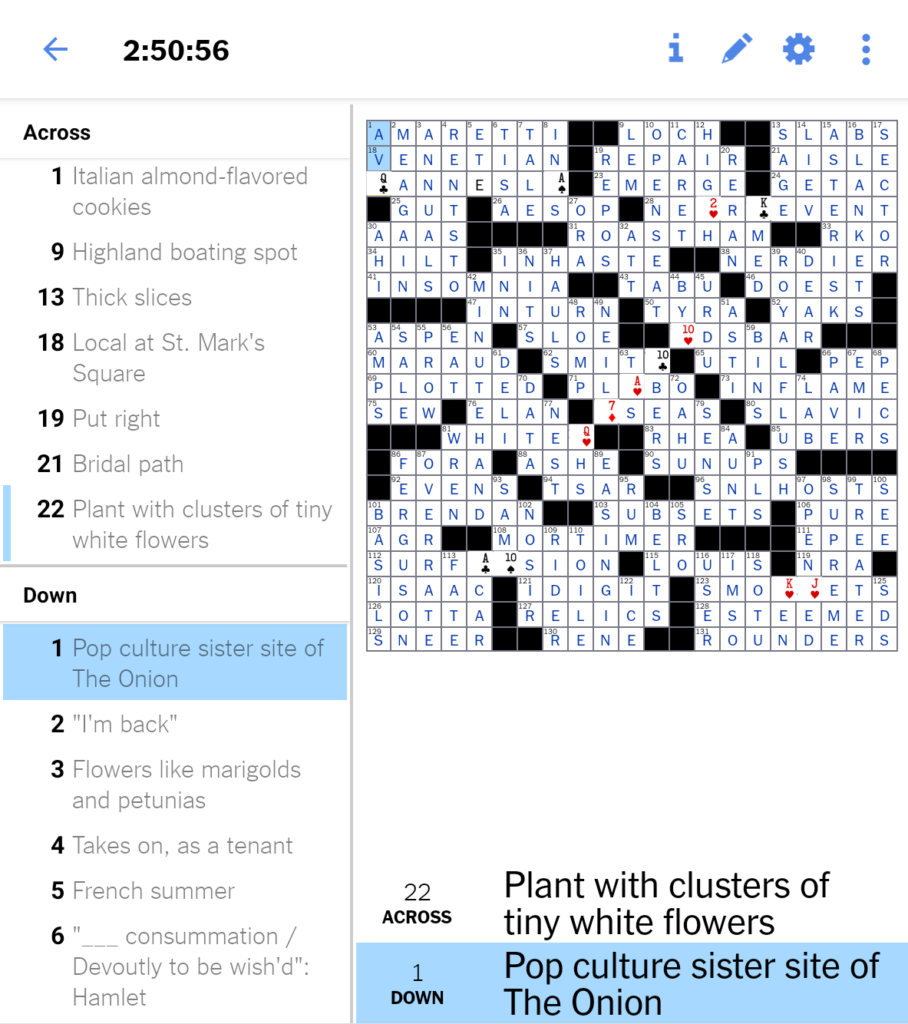
If they had stuck to the rules for entering rebus answers, or at least allowed the solver to enter them that way, there wouldn’t have been a problem. But it looks like they weren’t followed. I think they’re thought of more as suggestions, anyway.
Here is the puzzle, from yesterday, to the right.
You’ll notice some of the squares are overlaid with playing card icons. This is something the app does sometimes after you solve one, it superimposes an image to make the puzzle’s gimmick more apparent. It kind of gets in the way of showing the construction of the rebus answers here, though. Here’s another picture I took just before it solved below. This has been lightly photoshopped to remove my final errors (modesty).
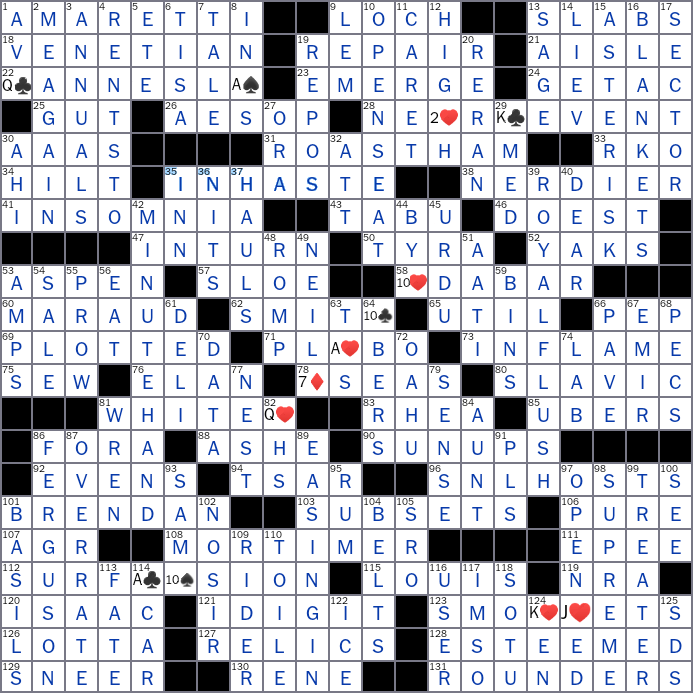
I was greatly sabotaged by trying to enter the symbols in this one. The gimmick was hinted by 39 Down: 123-Across’s holding that wins this puzzle’s game. A further hint is given by a title to this puzzle, a rarity for the NYT: It’s All On the Table. 39 Down’s answer turns out to be ROYAL FLUSH. The puzzle represents a game of Poker, of Texas Hold’Em in fact. The cards in the corners are each player’s hand (well, a shortened version of one containing only two cards; that was hinted at elsewhere), and the player in the lower-right can use their cards, with three of them from the middle of the puzzle, to make a royal flush. A great gimmick, if the UI doesn’t get in the way.
The worst thing about the app is when you understand the gimmick and know the answer, but a failure to grasp how it expects you to enter it into the puzzle prevents it from ever being marked right. Honestly forbids me from claiming that I got every other answer right, but even if I had, I’d never have been able to get this one solved in time because it didn’t adhere to the usual convention. To answer this one, you had to enter the first letter of the card followed by the symbol of its suit, like Q♣, or, oddly, the first letter of its suit, in this case: C. Entering neither QUEEN/CLUBS or Q/C would work!
The New York Times has a blog concerning its crossword puzzles, Wordplay. It’s run by serious crossword fiends, and has a post for every day’s puzzle. But it often gives out hints, which puts it off-limits during solving to the serious aficionado. Besides Wordplay is extra infamous, in our circle, when it explains answers, for never explaining the ones we really care about. In this case though it did offer information on how to enter the rebuses correctly, suggesting the first letter or the digits of the card’s rank, and its suit, with no slash between them. Like: QC. That would have been accepted, but Q/C wouldn’t. Didn’t.

Also considered cheating is the use of an internet search engine. Even if you aren’t trying to cheat specifically, clue autosuggests are rife with each day’s puzzle. You really have no idea unless you happen to enter a clue’s text into the Google box on the day of the puzzle’s publication. That company is absolutely desperate to spoil crosswords for you.
The worst part of the experience this time was that, even once the streak period had ended and checking errors was acceptable, I had written in AVC early on for 1 Down: Pop culture sister site of The Onion. The answer (slightly out of date) is AV CLUB. That was slightly out of form, since it’s usual that, if the answer is an abbreviation, that there should be one in the clue as well, but I’ve noticed this convention is not always strictly followed. And C was marked as correct for it, because it’s the first letter of Club.
Not only that! Although the symbols are accepted as correct answers, and look the nicest while solving the puzzle, I found out that all of those squares were still considered wrong by the the puzzle for some unknown reason. My friend who likes rebuses did an error check on the puzzle with his computer, with the Unicode symbols included, and they came up correct, but it wouldn’t on my app! What [five letters, transfers as property]?
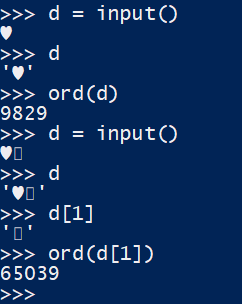
My friend was doing the puzzle in a web browser, and I was using the Android app. There is a very subtle bug in the app, when it’s checking rebus answers, that it has to be one of a number of exact matches recognized in the hidden puzzle solution. I was using Gboard as my input method, and it turns out a property of that keyboard is, for some symbols, it puts an extra, invisible Unicode character in after them! Unicode #65039, VARIATION SELECTOR-16. With that invisible symbol in any of the boxes, there was absolutely no way that my puzzle would be accepted as correct. And, anyone using Gboard to input symbol-like glyphs is going to encounter this same problem.
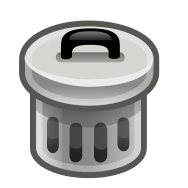
I have filed this with the developer as a bug report, which I’m sure they’ll put with my other reports in the usual file (see left). Every avid cruciverbalist (23 points) no doubt has stories like this to tell. It does seem like this happens fairly often with me though.
EDIT: Made a couple of minor corrections and clarifications.
In memory of Nancy “Rosaleah” Klee, a kind old lady who loved crosswords. Not one of the friends I refer to above, but still, my friend.
